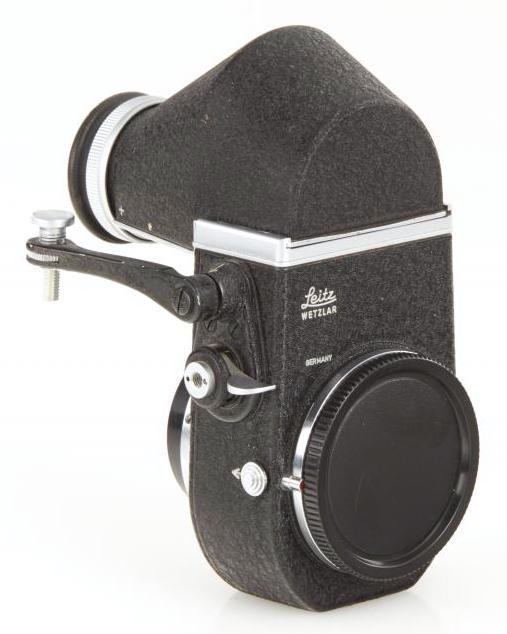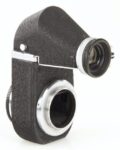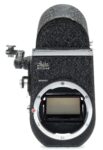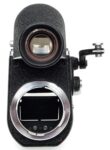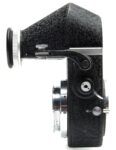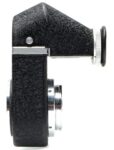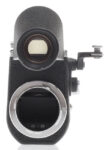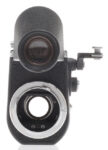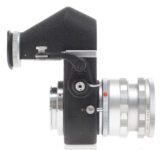Leitz Wetzlar Visoflex II
Reflex housing
Manufacturer description #1
From the LEICA photography magazine (1958, No. 4):
A completely redesigned reflex-focusing housing - the Visoflex II - is another interesting newcomer to the Leica System. Since it is considerably shallower, front to back, than the former Visoflex, the II will permit properly mounted 90mm lenses to focus from infinity down to 3 1/2 feet.
A single rigid arm on the Visoflex II releases both its mirror and the camera shutter; adjustment of the time-lag between mirror release and shutter release is made very simply via a knurled ring.
Two magnifiers will be available - one (4X) for eye-level use, a second (5X) for convenience when the camera is held below eye level.
The Visoflex II will be produced in both screw- and bayonet-mount models to fit all Leica models with interchangeable lenses. Adapter rings will be available so that lenses from 90mm to 400mm focal length can be used with the new Visoflex II. Prices and availability will be announced later.
Manufacturer description #2
From the LEICA photography magazine (1959, No. 1):
Perhaps the most striking thing about the new Visoflex is its compactness. Since it is 22.5mm shallower than the Visoflex I, it will focus even 90mm lenses (in short mount) to infinity. Both the new 90mm Summicron f/2 in short mount and lens units of the 90mm Elmar f/4 in special focusing mount can be used on the Visoflex II. (The collapsible, bayonet-mounting 90mm Elmar cannot be used, since its lens unit is not removable.) The extension tube OTQNO used on the Visoflex II makes possible close-range focusing between 40 and 26 inches with the rigid 90mm Elmar lenses.
rigid release bar
Another feature of the Visoflex II is its single, rigid shutter-and-mirror release bar. One press of this bar trips both the reflex mirror and the Leica shutter in proper sequence. A simple knurled ring adjusts the bar to fit individual camera shutter releases and insures a rapid, correctly-timed sequence of shutter and mirror release. Pressing a second lever (positioned to fall naturally under the middle finger of your right hand) returns the mirror to viewing position instantly. For those who use a cable release when working from a tripod or copying stand, there is a special socket which accepts the cable release which fits the "M" model Leicas. The cable release trips both mirror and shutter - the same result as using the rigid release bar, but with less chance of vibration on long exposures.
lens adapter
The short-mounted 90mm Summicron lens is designed to fit the Visoflex II, and the lens units of other rigid-mount 90mm Elmar lenses also fit the new housing when used in a special focusing mount. But the mounts of the 125mm, 135mm Hektor (short mount), 200mm and 400mm Leica lenses require an adapter which bayonets to the front of the Visoflex II. This is because these lenses are designed for the Visoflex I, which is deeper, front to back, than the new housing. The adapter adds the necessary length to make the lenses focus properly on the film plane.
The adapter permits the Visoflex II, with camera attached, to be rotated through 90° for taking vertical pictures while working from a tripod. When the adapter is not used (as with the short-mounted 90mm lenses) a ball-joint tripod head is necessary to take verticals from a tripod. The Visoflex II and the special adapter for long-focus lenses have both European- and American-thread tripod sockets.
two magnifiers
The compactness and the single release-bar of the Visoflex II suit it admirably for hand-held camera work, especially when it is used with the direct-vision magnifier. This 4X magnifier contains a prism and yields an upright, unreversed image which is ideal for eye-level shooting of general scenes and action pictures. A 5X simple magnifier is used for pictures taken from a vertical copying stand or for extra-low angle shots. It produces an upright, but laterally reversed image. Both magnifiers are adjustable to compensate for individual eyesight variations from +1.5 to -2 diopters. The superfine grain of the ground glass screen and the high light transmission of the magnifiers combine to produce an exceptionally brilliant image with incomparable corner-to-corner sharpness for fast, easy focusing and framing of the subject.
The Visoflex II will be available in both screw- and bayonet-mounting models. However, the screw- mounting model cannot be adapted for use with "M" model Leicas via a bayonet adapter, because the shutter release button is differently positioned on the M 2 and M 3 than it is on screw-mounting Leicas. The screw-mounting Visoflex II is designed to fit older, threaded models of the Leica, as well as the Ig and Illg. But, since the former are somewhat lower in height than the "g" cameras, the shutter release bar of the new housing includes a small, removable stud which provides extra "reach" for the release bar when it is used on "f" series or earlier Leicas.
Manufacturer description #3
The VISOFLEX II is an accessory that enables you to change the rangefinder Leica into a compactly efficient single-lens reflex camera whenever you wish. This marvel of 35mm versatility and enjoyment is a pivotal member of the Leica System, the world's most complete system of photography.
Choice between rangefinder and through-the-lens photography is not just a matter of taste. Each has definite advantages; that's why both have always been provided for in the Leica System.
When short and normal lenses are being used at normal distances, rangefinder viewing and focusing is easier and very much more accurate. Through-the-lens viewing and focusing offers advantages when long lenses are being used or in extreme close-up photography.
When you own a Leica, you may choose from rangefinder-coupled lenses 21mm to 135mm in length. With the same Leica and a VISOFLEX II, you may use lenses from 65mm to 400mm in length. A number of the lenses can be used with both systems. Designed for fast hand-held shooting and eye-level comfort, the VISOFLEX II delivers an upright, unreversed image on a ground-glass screen so fine-grained and clear you forget it's there. You also forget the VISOFLEX II is there, it's so compact and so much a part of the Leica. The smooth precision operation is typical of any Leica-accessory combination.
Manufacturer description #4
The Leica is designed to cope with every photographic situation with speed and certainty - designed to give pictures that are full of life.
More than three decades of leadership in the 35 mm camera field have culminated in the Leica M 3 and M 2, along with an extensive line of lenses and accessories which constitute the Leica System. The basis of this system is the Leica "M" combined range-viewfinder, undoubtedly the fastest, most accurate and easiest to use of all focusing devices. With ultra-bright rangefinders and built-in viewfinder lens-field indication and automatic parallax compensation over the full focusing range, the Leica M 2 and M 3 permits even a beginner to focus quickly and easily even when working in dim light or with high-speed lenses.
There are, however, occasions in which reflex focusing and viewing of a completely parallax-free groundglass image is preferable as, for example, in close-up work, macrophotography, and when using telephoto lenses. Here the Leicaman has the advantage of the Visoflex II which instantly converts his rangefinder Leica to a compactly efficient single-lens reflex. More than this, the 90- and 35 mm Leica lenses may actually be employed with either rangefinder or reflex focusing. This enables the Leicamen to choose not only the best focal length, but the ideal focusing method for individual subject conditions as well.
VISOFLEX II details
- Simple 5x magnifier (laterally reversed image) 16 461 with eyesight adjustment from +2 to -1.75 diopters
- Image-erecting, right-way-round 4x prism magnifier 16 460 with eyesight adjustment from +1.75 to -2.5 diopters
- Release button with (beneath it) adjusting screw for timing mirror movement and shutter release
- Release lever acting directly on LEICA release button, causing reflex mirror to rise before shutter is released
- Bayonet fitting (or threaded mount) for attaching VISOFLEX II to LEICA camera body
- Conical thread for standard cable releases
- Adjusting screw for aligning screw-thread VISOFLEX II with thread-mount LEICA camera
- Finegrain groundglass focusing screen with etched-in black circle to aid in individual eyepiece adjustment
- Return-lever for reflex mirror
- Reflex mirror
- Catch for locking or releasing the interchangeable lenses
- Tripod sockets, 3/8 inch and 1/4 inch
Special advantages of the VISOFLEX II, reflex housing for the LEICA
The VISOFLEX II attaches to the LEICA in exactly the same way as an interchangeable lens, thus giving you the opportunity of using reflex viewing and focusing without sacrificing the inherent technical advantages of the combined range-viewfinder of your LEICA M 2 or M 3.
Because the VISOFLEX II is an independent unit it has been possible to provide a very large mirror groundglass and magnifier which ensures maximum viewing brightness and focusing accuracy with even illumination out to the picture edges. The VISOFLEX II has a true groundglass which increases focusing speed and accuracy by virtue of its great brightness. The groundglass image has the full size of the LEICA frame.
The large viewing magnifiers with focusing eyepieces are readily interchangeable for horizontal or vertical camera positioning and enlarge the groundglass image 4x or 5x respectively.
For infinity focus the VISOFLEX II accepts LEICA lenses with focal lengths from 65- to 400 mm. Shorter-focus LEICA lenses are adaptable for extreme close-up and macro applications. The LEITZ FOCUSING BELLOWS II, a new accessory for the VISOFLEX II greatly simplifies and facilitates the problems of close-up photography.
Note: An improved Visoflex, the IIa, is now available, in addition to the Visoflex II. It is virtually identical to the Visoflex II but features an automatic, rapid-return mirror. A Visoflex II can be converted to a IIa.
From the editor
Introduced in 1958.
A lighter and more compact reflex housing with optical thickness reduced to 40mm to allow lenses of 65mm and above to be focused to infinity.
Visoflex IIa (1962) offered the choice of automatic mirror reset or mirror locked up when pressure on the release was relaxed. The mirror reset lever was replaced with a knurled knob engraved with a black and a red dot to indicate the selected mirror setting.
Micro-Visoflex II was a special version for micro work with interchangeable plain and ground glass screens which had a D-shaped finger grip and were slid into rails on the top of the Visoflex body. This version also had a special focusing magnifier, rising to a much flatter eyepiece than the standard OTVXO.
Code words: OCLOM / 16456 - with image erecting 4x prism magnifier, bayonet mount, OUCLO / 16458 - with image erecting 4x prism magnifier, screw mount, OTDYM / 16455 - without magnifier, bayonet mount, OTYDO / 16457 - without magnifier, screw mount, 98303 - IIa, bayonet mount, 98304 - IIa, screw mount.
